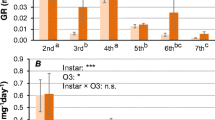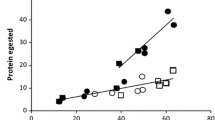Abstract
Bioenergetica, efficiencies of energy transfer and growth of Spodoptera litura larvae reared on mulberry, cabbage, castor and wild hempweed leaves were determined using calorimetrie procedures. Energy contents (J mg-1 ash-free tissue) of castor leaves were higher than those of cabbage, mulberry and wild hempweed. Fresh leaves had slightly higher energy contents than those left over. The rates of ingestion and egestion of food energy increased linearly with the age of larvae. Energy consumption decreased exponentially with larval age, and this decreasing trend showed an intermediate rise at the fifth instar. Assimilation efficiencies were highest and lowest for the first and sixth instar larvae respectively. Efficiencies of gross and net larval production showed linear increases with instar stage, except at the fifth instar which showed dramatic declines in conversion of ingested and assimilated energy into insect biomass. Efficiencies of gross and net productions during early first to third instars were low, but those during the sixth instar were high. The pathways of energy transfer indicated that an average of 58.5% of the total energy ingested was lost directly through faeces, respiration and exuviae, while about 42.2% of the total energy ingested was actually converted into growth of an S. litura larva.
Résumé
La bioénergétique, les efficiences de transfert d’énergie et la croissance des larves de Spodoptera litura élevées sur des feuilles de mûrier, de choux, de ricin et de chanvre sauvage respectivement ont été determinées par des procédés calorimétriques. Les teneurs en énergie (J mg1 du tissu sans cendre) des feuilles du ricin étaient supérieres à celles du choux, du mûrier et du chanvre sauvage. Les feuilles offertes à l’état frais avaient des teneurs en énergie légèrement supérieures à celles des reliquats. Les taux d’énergie d’ingestion et d’éjection de nourriture augmentait linéairement avec l’âge des larves. L’énergie de consommation décroissait exponentiellent avec l’âge des larves et cette tendence de décroissance présentait une augmentation intermédiare au cinquième stade. Les efficiences d’assimilation avaient les valeurs les plus élevées au premier stade et les plus basses au sixième stade. Les efficiences de production brute et nette du stade larvaire présentaient des taux de croissance linéaires avec le stade, sauf le cinquième stade avec des baisses formidables dans la conversion d’énergie ingérée et assimillée en biomasse de l’insect. Les efficiences de production brute et nette étaient basses du premier au troisième stade mais elles étaient élevées au cours du sixième stade. Les voies de transfert d’énergie ont montré qu’en moyenne 58.5% de l’énergie totale ingérée était directent perdue en fèces, en respiration et en exuvies; cependant environ 42.2% de l’énergie total ingérée était convertie en croissance chez une larve de S. litura.
Similar content being viewed by others
References
Ali A., Luttrell R. G. and Schneider J. C. (1990) Effects of temperature and larval diet on development of the fall army worm (Lepidoptera: Noctuidae). Ann. Entomol. Soc. Am. 83, 725–733.
Banerjee T. C. and Haque N. (1984) Dry-matter budgets for Diacrisia casignetum larvae fed on sunflower leaves. J. Insect Physiol 30, 861–866.
Banerjee T. C. and Haque N. (1985) Influence of host plants on development fecundity and egg hatchability of the arctiid moth Diacrisia casignetum. Entomol. exp. appl. 37, 193–198.
Campbell A., Singh N. B. and Sinha R. N. (1976) Bioenergetics of the granary weevil Sitophilus granarius (L.) (Coleoptera: Curculionidae). Can. J. Zool. 54, 786–798.
Duncan A. and Klekowski R. Z. (1975) Parameters of an energy budget, pp. 97–147. In Methods for Ecological Bioenergetics (Edited by W. Grodzinski, R. Z. Klekowski and A. Duncan). Blackwell Scientific Publications, Oxford.
Duodu Y. A. and Biney F. F. (1981) Growth, food consumption and food utilization of Spodoptera littoralis (Boisduval) (Lepidoptera: Noctuidae) on four food plants. Bull entomol Res. 71, 655–662.
Hill D. S. (1983) Agricultural Insect Pests of the Tropics and Their Control. Cambridge University Press.
Hogg D. B., Pitre H. N. and Anderson R. E. (1982) Assessment of early season phenology of the fall armyworm (Lepidoptera: Noctuidae) in Mississippi. Environ. Entomol 11, 705–710.
Hubbell S. P. (1971) Of sowbugs and systems: The ecological bioenergetics of a terrestrial isopod, pp. 269–324. In System Analysis and Simulation in Ecology (Edited by B. C. Patten)
Jalali S. K., Singh S. P. and Ballal C. R. (1987) Role of the host plants of S. litura (Fabricius) on the degree of parasitism by Cotesia marginiventris (Cresson) (Hymenoptera: Braconidae). Indian J. Agric. Sci. 57, 676–678.
Mahapatra A. K. and Banerjee T. C. (1990) Bioenergetics of Argina cribraria (Clerk) larvae fed on sunnhemp leaves. Indian J. Exp. Biol. 28, 771–775.
Martin M. M. and Van’t Hof H. M. (1988) The cause of reduced growth of Manduca sexta larvae on a low-water diet: Increased metabolic processing costs or nutrient limitation? J. Insect Physiol. 34, 515–525.
Muthukrishnan J. and Pandian T. J. (1987) Insecta, pp. 373–511. In Animal Energetics—Protozoa through Insecta (Edited by T. J. Pandian and F. John Vernberg). Academic Press, London.
Petrusewicz K. and Macfadyen A. (1970) Productivity of Terrestrial Animals—Principles and Methods. IBP Handk. No. 13. Blackwell Scientific Publications, Oxford.
Phillipson J. (1964) A miniature bomb calorimeter for small biological samples. Oikos 15, 130–139.
Prasad J. and Bhattacharya A. K. (1975) Growth and development of Spodoptera littoralis (Boisd.) on several plants. Z. angew. Entomol. 79, 34–48.
Prasad D. and Chand P. (1980) Consumption and utilization of various food plants by Diacrisia obliqua (Walker). Indian J. Ent. 42, 192–196.
Prus T. (1975) Methods for Ecological Bioenergetics, pp. 149–160 (Edited by W. Gordzinski, R. E. Klekowski and A. Duncan). Blackwell Scientific Publications, Oxford.
Ray D. and Banerjee T. C. (1993) Bionomics and feeding capabilities of Spodoptera litura (Fabr.) (Lepidoptera: Noctuidae). Phytophaga 5, 51–62.
Reese J. C. and Beck S. D. (1978) Inter-relationships of nutritional indices and dietary moisture in the black cutworm Aqrotis ipsilon digestive efficiency. J. Insect Physiol. 24, 473–479.
Schroeder L. A. (1973) Energy budget of the larvae of the moth Pachysphimx modesta. Oikos 24, 278–281.
Schroeder L. A. (1977) Distribution of caloric densities among larvae feeding on black cherry tree leaves. Oecologia 29, 219–222.
Scriber J. M. (1977) Limiting effects of low leaf water content on the nitrogen utilization, energy budget and larval growth of Hyalophora cecropia (Lepidoptera: Saturniidae). Oecologia 28, 269–287.
Scriber J. M. (1984) Larval food plant utilization by the world Papilionidae (Lepidoptera): Latitudinal gradients reappraised. Tokurana (Acta Rhopalocerologica) 2, 1–50.
Scriber J. M. and Slansky F., Jr. (1981) The nutritional ecology of immature insects. Annu. Rev. Entomol. 26, 183–211.
Slansky F., Jr. (1978) Utilization of energy and nitrogen by larvae of the imported cabbage-worm Pieris rapae as affected by parasitism by Apanteles glomeratus. Environ. Entomol. 7, 179–185.
Slansky F., Jr. and Feeny P. (1977) Stabilization of the rate of nitrogen accumulation by larvae of the cabbage butterfly on wild and cultivated food plants. Ecol. Monographs 47, 209–228.
Soo Hoo C. F. and Fraenkel G. (1966) The consumption, digestion and utilization of food plants by a polyphagous insect Prodenia eridenia (Cramer). J. Insect Physiol. 12, 711–730.
Timmins W. A., Bellward K., Stamp A. J. and Reynolds S. E. (1988) Food intake, conversion efficiency and feeding behaviour of tobacco hornworm caterpillars given artificial diet of varying nutrient and water content. Physiol. Entomol. 13, 303–314.
Tohiuddin G., Ray D. and Banerjee T. C. (1993) Energy reserves of adult pulse beetle Callosobruchus chinensis (Coleoptera: Bruchidae) reared on seeds of gram Cicer arietinum. Indian J. agric. Sci. 63, 181–185.
Van’t Hof H. M. and Martin M. M. (1989) The effect of diet water content on energy expenditure by third-instar Manduca sexta larvae (Lepidoptera: Sphingidae). J. Insect Physiol. 35, 433–436.
Waldbauer G. P. (1968) The consumption and utilization of food by insects. Adv. Insect Physiol. 5, 229–269.
Author information
Authors and Affiliations
Additional information
See Editor’s Note at the end of this issue.
Rights and permissions
About this article
Cite this article
Banerjee, T.C., Ray, D. Bioenergetics and Growth of the Fall Armyworm, Spodoptera litura (F.) Larvae Reared on Four Host Plants. Int J Trop Insect Sci 16, 317–324 (1995). https://doi.org/10.1017/S1742758400017343
Accepted:
Published:
Issue Date:
DOI: https://doi.org/10.1017/S1742758400017343
Key Words
- fall armyworm
- host plant
- Spodoptera litura
- bioenergetics
- energy utilisation efficiency
- energy transfer
- growth




